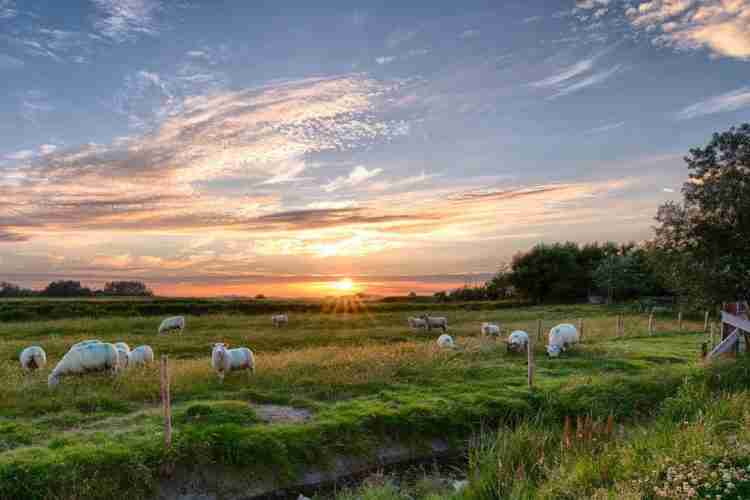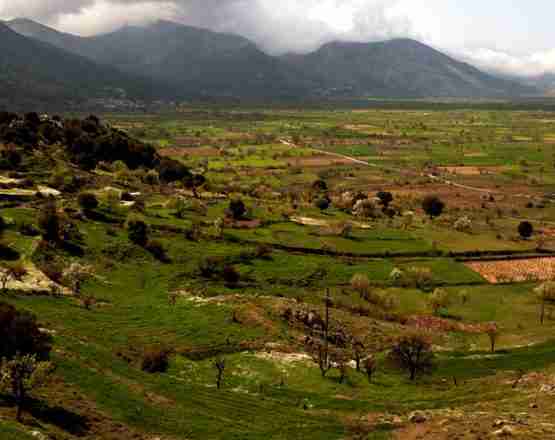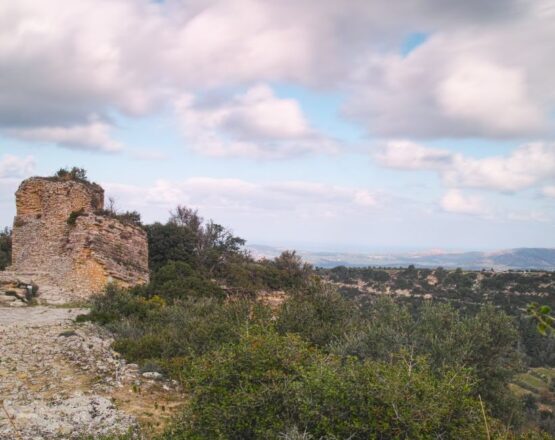|
There are cave drawings in the Vernofeto Cave at Kato Pervolakia (Sitia district) which indicate that the cave was used for rituals of pastoral magic. Goats are shown, one being netted. A crouching female, possibly a priestess or goddess, holds a bow and arrow with her arms upraised: a dog is near her. Below is a fishing scene, with three men in three boats casting nets for several different sorts of seafood, including octopus, dolphin and starfish. It is one of the clearest examples of sympathetic magic in ancient Crete and is thought to date from around 1400 BC
But to return to the sheep.
A clay dish found in the Minoan town of Palaikastro contains a model of a flock of sheep with their shepherd. The Knossos tablets add documentary evidence by listing very large numbers of sheep. The total mentioned for the Labyrinth’s final year, around 1380 BC, runs to about 100,000 sheep.
The numbers of lambs are carefully noted, presumably so as to keep a check on the everchanging strength of the flocks. The tablets record target figures for flocks and for wool production. The target is one unit of wool, about 3 kilograms, for every four sheep, or about 750 grams per sheep, which agrees with the quantity of wool expected from sheep in the medieval period. Breeding flocks yielded less because lambs produce no wool in their first spring. The tablets give the names of ‘sheep officials’ or owners, who are presumably not the shepherds. A second name on some of the tablets seems to indicate a dedication to either a deity or a named citizen.
Livestock farming was a major element in the Minoan economy. In the New Temple Period, according to Nicolas Platon (1968), there is much evidence of large-scale breeding of cattle, sheep, goats, and pigs. There were domestic goats in Minoan Crete and it is suggested, by Hood (1971), that the wild goats of bezoar stock (the agrimi or Cretan ibex) may really be feral, i.e. descendants of Minoan domestic goats that escaped or were deliberately turned loose back in the Minoan period.The creatures so carefully depicted by Minoan artists, creatures with long horns knobbed at intervals, look very similar to the modern wild goats, yet they are often shown in domesticated situations, such as drawing goat-carts or sitting on the roof of a temple. At the same time, similar-looking goats were portrayed leaping through mountainous landscapes or being chased by hunters; in other words, in the Minoan period there was little difference between the wild and the domesticated goat.
No doubt flocks of goats and sheep were driven back and forth by herdsmen, wintering on the low ground and spending the summers on the high pastures. Paul Faure (1973) believes that the shepherds’ dwellings in the high pasture became surrounded by mystique, and that they served as places of initiation. Faure draws on the substantial and very peculiar folklore which surrounded shepherds in the later, classical period. The shepherds’ folklore includes strange three-eyed giants, the Triametes, who were both cunning and cruel: the third eye, on the nape of the neck, looked backwards. The man-eating Triametes were a Cretan variation on the cyclops Polyphemus.Odysseus’ experience with the cyclops represents a bronze age initiation in which the young shepherd became a mortal master of animals. Some of the caves high in the mountains have a sinister reputation; they are places where you can throw the beasts of your enemy if you wish to take revenge on him for some wrong. Faure speculates that many of the deeply entrenched rural customs of Crete may be Minoan in origin, but it would be rash to assume this.J. L. Bintliff (1977) has reconstructed the likely seasonal movements of flocks in central Crete. There were Minoan farming villages at Sphakia, Anogeia, Kroussonas, Gergeri, Zaros, Vorizou and Kamares. From these, flocks were taken up in the spring to graze on the Nida Plain, with the peak shrine and sacred caves of Mount Ida probably developing as a ritual focus later.After spending the summer on the Nida Plain the flocks moved down to spend the winter on the low hills in the Phaistos area. There is a clear association between the migration to the high summer pastures and the development of the peak sanctuaries and high caves as cult centres. Pigs were apparently domesticated in Crete as early as the neolithic period. In Minoan times they were widely distributed but in fairly low numbers. At Knossos, single pigs were being offered in tribute, probably as special offerings for sacrifice. Cattle were reared from neolithic period.
Their bones, along with those of sheep and goats, were recovered from the earliest neolithic level at Knossos. The Cretan cattle, introduced into the island by the same generation of neolithic occupants who built the first village at Knossos, were brought in from elsewhere, a breed apparently descended from the giant long-horned Bos primigenius. The cattle may have been kept principally for their milk rather than for their meat. They also served as draught animals, and their skins were used to make the large figure-of-eight shields carried by warriors and hunters.
Cattle featured in the bull games, a major religious rite. It seems that the bulls were sometimes sacrificed after the games, but there is no direct or necessary connection between the two rites. Bull-leaping and -grappling evidently started very early in Crete, whereas most of the evidence of cattle sacrifice comes from the fourteenth century BC, and then often in connection with funerary rites.The bulls used for the bull games are shown on the frescoes as having dappled hides, implying that they were domesticated, not wild, but their behaviour may well have been fairly unmanageable if they were allowed unmanageable if they were allowed to live in a semi-wild state. The scene of bull capture on one of the Vaphio cups shows how dangerous netting one of these half-wild beasts could be captured.
Dogs are known to have existed in Minoan Crete. The handles on some Early Minoan stone pot lids are shaped like relaxing dogs. It seems that the dogs were used mainly in hunting. At Pylos, the term ‘hunters’ literally means ‘dog-leaders’, proving that dogs were used in this way. On a sealstone apparently dating to Middle Minoan III, a collared dog is shown barking at a goat cornered on the rock above. A chalcedony seal with gold end-mounts found in a Late Minoan tomb at Knossos shows a dog of mythic size wearing an embossed collar.Evans suggested that this was a sacred dog, reminiscent of those described at the classical temple of Diktynna, a goddess with a pre-Greek name and pre-Greek origins; it seems that a Minoan goddess, called Diktynna, had sacred dogs in her service on the rugged headland of Spatha, to the west of the Minoan city of Kydonia. John Chadwick (1976) regrets that he sees no evidence of cats, but Sinclair Hood (1971) suggests that some of the Minoan sealstones do show catsOne very finely carved Middle Minoan seal has a cat-like symbol engraved on it; Evans proposed that the cat may have been the personal badge of a Cretan prince, which seems to be going too far. Another seal shows a cat attacking a group of water-birds. Domestic cats had been trained to hunt wildfowl in the marshes, and it may be that they were introduced to Crete from Egypt for the same purpose. An inlaid dagger from Mycenae, but probably made by a Cretan, shows golden cats again stalking water-birds, with fish and clumps of papyrus.It is not certain whether the Minoans had chickens.
The people of the Indus valley civilization were domesticating fowl by the year 2000 BC, but there is no mention of them in Egypt until the early fifteenth century BC, when they are mentioned elliptically as ‘the birds that give birth every day’. The chicken may have been introduced to Crete at about this time: a clay vase from Agia Triadha looks rather like a caricature of a chicken. Cats and dogs were used to help in hunting, and the wild mountain sides of Minoan Crete were rich in game of all kinds.In addition to the water-birds and wild goats already mentioned, there were deer and wild boar. The boar were dangerous wild animals and were doubtless hunted as a pest mainly, but their meat was probably welcome too. Their tusks are found among kitchen refuse, both at Knossos and elsewhere on Crete. It is possible that lions prowled there too. They were still in existence in Macedonia in the fifth century BC, so they may well have existed on Minoan Crete.
Lions were often shown on Early Minoan and later sealstones. On Late Minoan seals they are often shown attacking other animals such as wild deer or cattle. Lions would have been regarded as a destructive menace, devourers of cattle, game and men, and pursuing and killing them a test of a warrior’s skill and courage. The best-known Mycenean dagger shows a pride of lions being hunted by men with shields, spears and bows; even though it was found in one of the shaft graves at Mycenae, it was probably made by a Cretan craftsman, and may conceivably show a scene on Crete. Lions are shown as sacred animals, attendant upon Minoan deities.One seal shows a lion walking along beside an armed goddess, and evidently accompanying rather than stalking her; another, apparently its pair, shows a lioness walking beside a god armed with a spear and a square shield.
Monkeys may have found their way, like cats, from Egypt. They appear in several wall paintings dating to the sixteenth century BC at Knossos and Akrotiri; the fossilized head of a monkey was identified – although it may have been a stone – among the debris of the fifteenth-century eruptions of Santorini .Nevertheless, monkeys do appear in Minoan art and, significantly, they are painted blue, according to the contemporary Egyptian convention. They were also included in Middle Minoan jewellery and appear on Early Minoan seals: some of the early sealstones even have monkeys carved in the round as handles. The monkey may have been a sacred animal, but it may also have been caught for its meat, as it still is in the equatorial forests.Wild birds were probably also part of the Minoans’ diet. As we have seen, cats may have been used to stalk and catch them, as shown on Late Minoan seals. Partridges and hoopoes may have been caught for food as well; these two birds appear in a frieze painted round the walls of one of the chambers of the Pilgrim Hostel at Knossos. Hoopoes are still summer visitors to Crete and Evans believed that they were regarded as a special delicacy in the eastern Mediterranean region in the Minoan period. Set against this, though, is the Jewish prohibition against eating the hoopoe, under the name ‘lapwing’, on the grounds that it is unclean. A law of this kind suggests an ancient prejudice against eating the hoopoe in the Levant at least. Perhaps we should not be so quick to read the frieze at the Pilgrim Hostel as a menu. Even so, the natural environment of ancient Crete brimmed with food. Bees were important in the Minoan economy, as the honey they produced was the main source of sugar. Egyptian bees were kept in horizontal clay cylinders with a flight hole at one end and a larger smoke hole at the other. When the honey was to be extracted, smoke was blown in to clear the tube of bees. As yet, no clay beehives have been found, or at any rate recognized, from Minoan Crete. Hood suggests that the honey of wild bees may have been gathered from rocky clefts or hollow trees, but it may be that hives were built partly or wholly of wood and that they have simply not survived in the archaeological record. Some containers seem to have been made in the shape of modern hives; it is possible that one of the symbols of the Phaistos Disc (Evans’ symbol number 7) shows the shape of a Minoan beehive. The bee was used as a decorative motif. The famous gold pendant found at Mallia seems to show a pair of bees kissing. It has been proposed that it may be a pair of wasps fighting instead, on the grounds that the insects look more like wasps or hornets; on the other hand the Egyptians, with whom the Minoans shared many conventions, tended to portray bees in this way, so it is a difficult image to interpret
|



